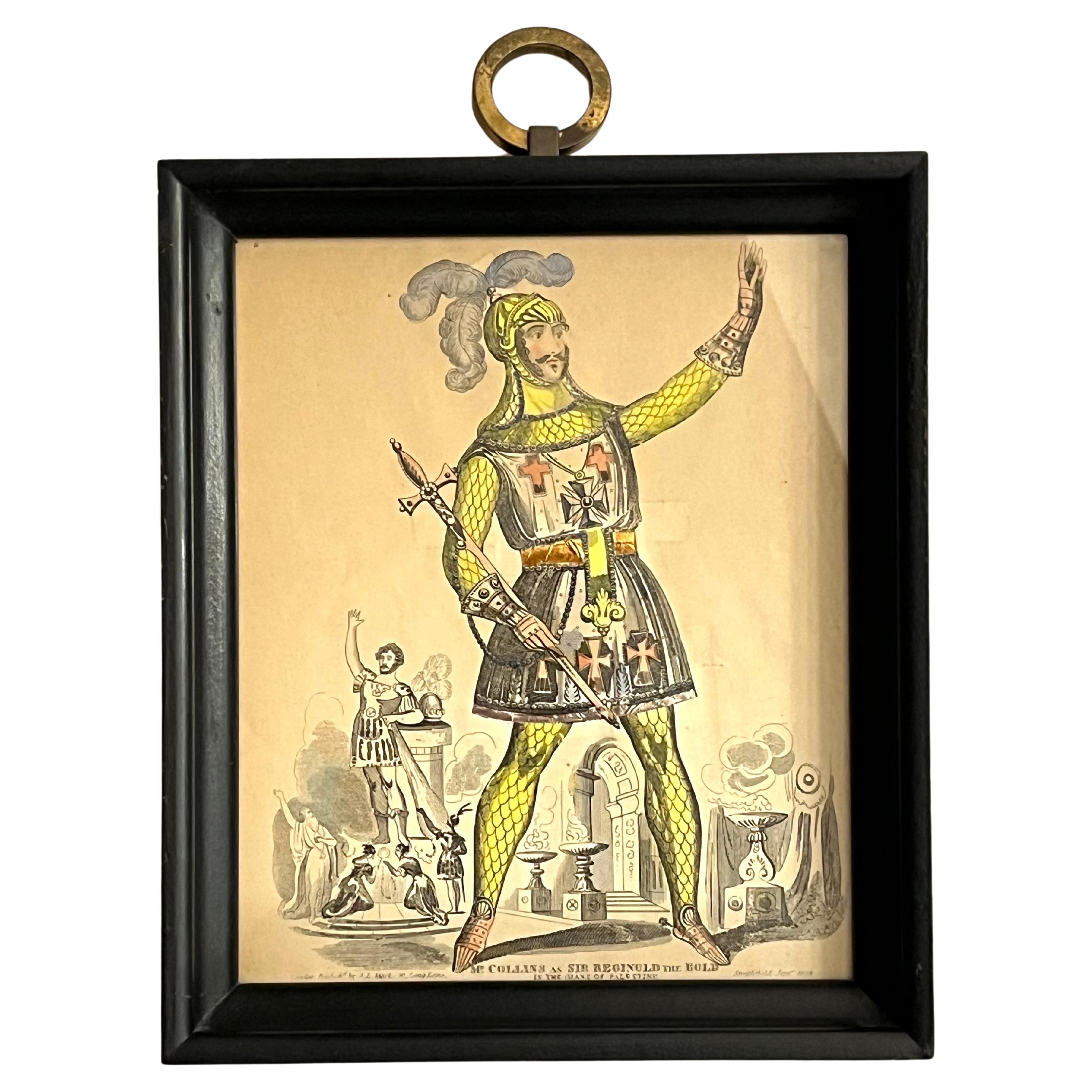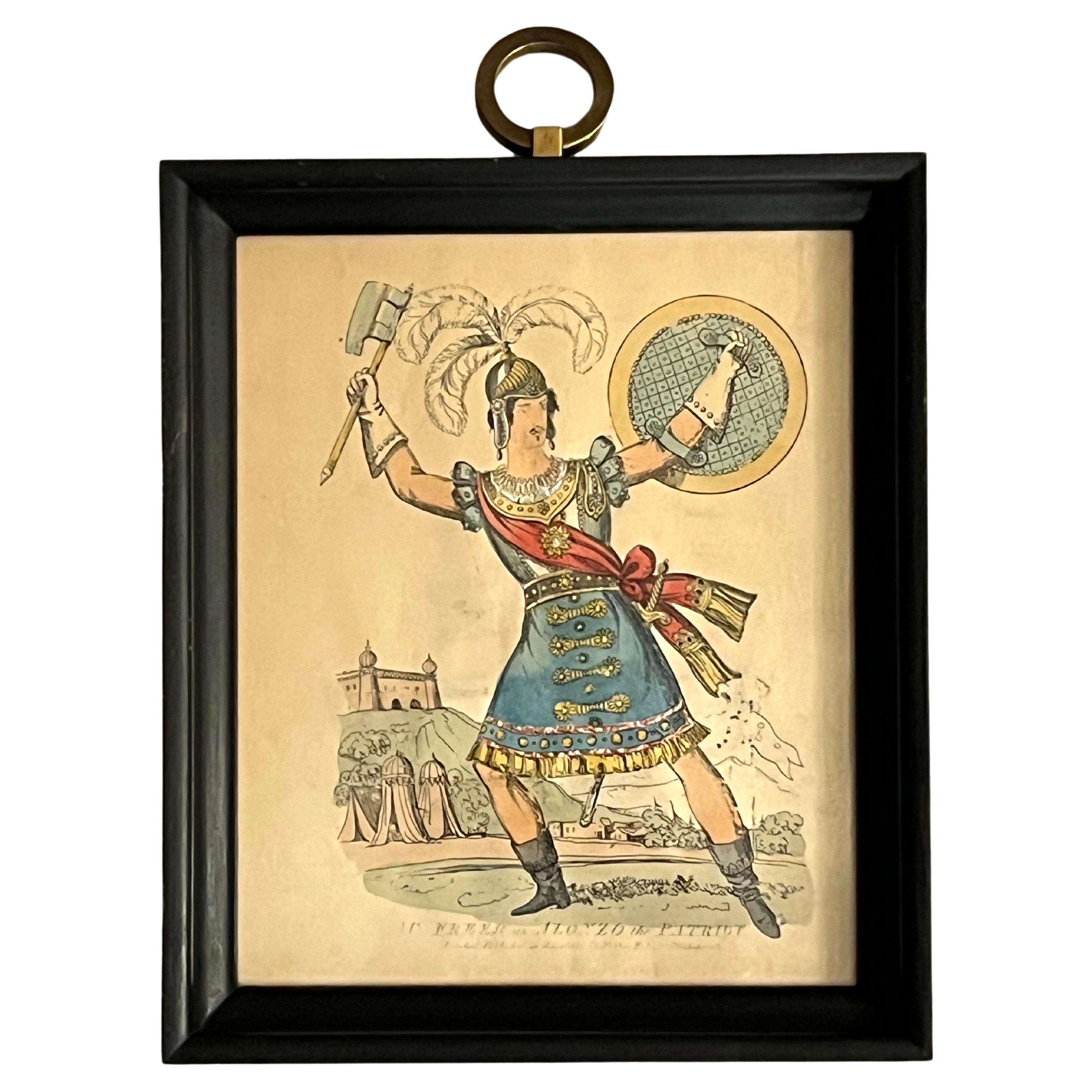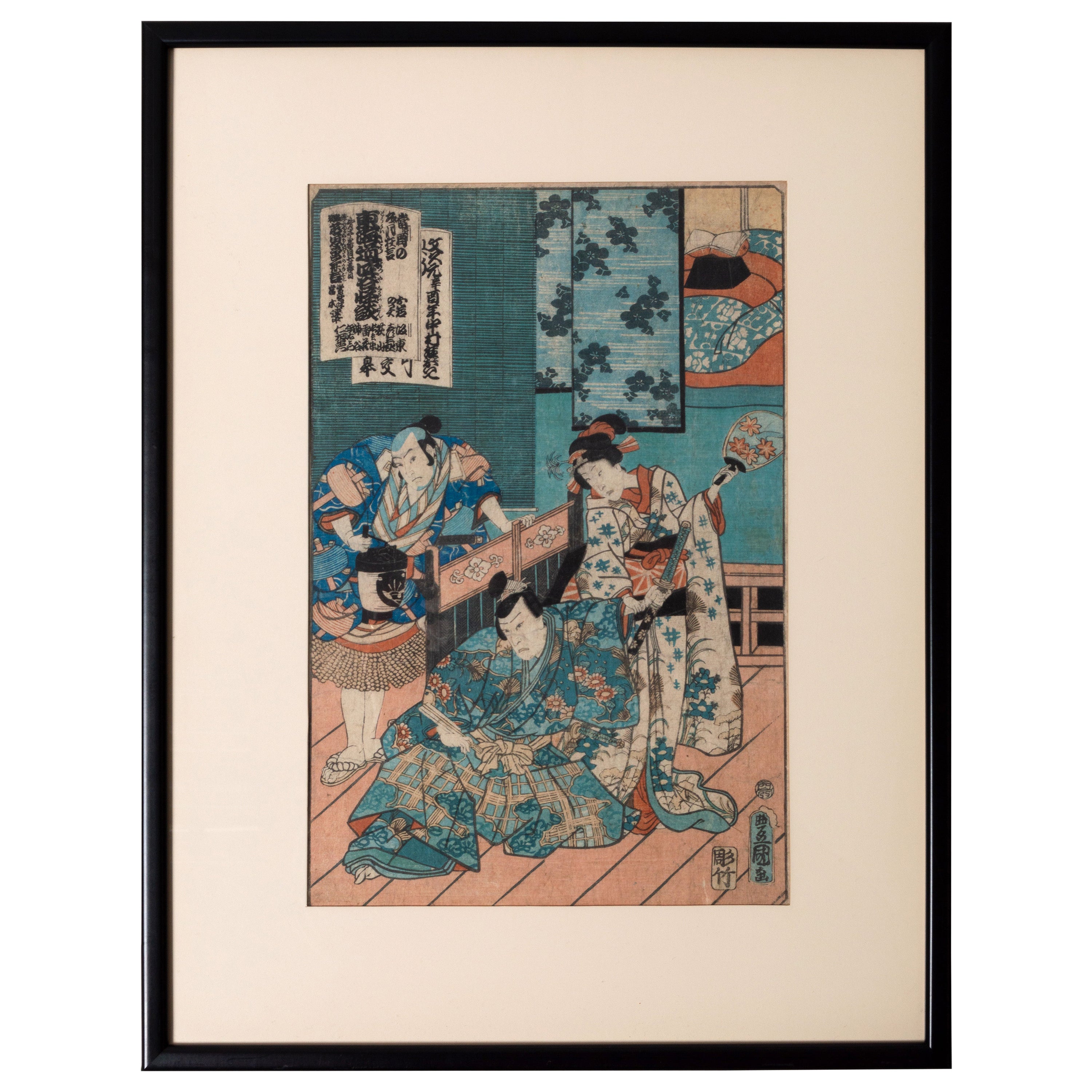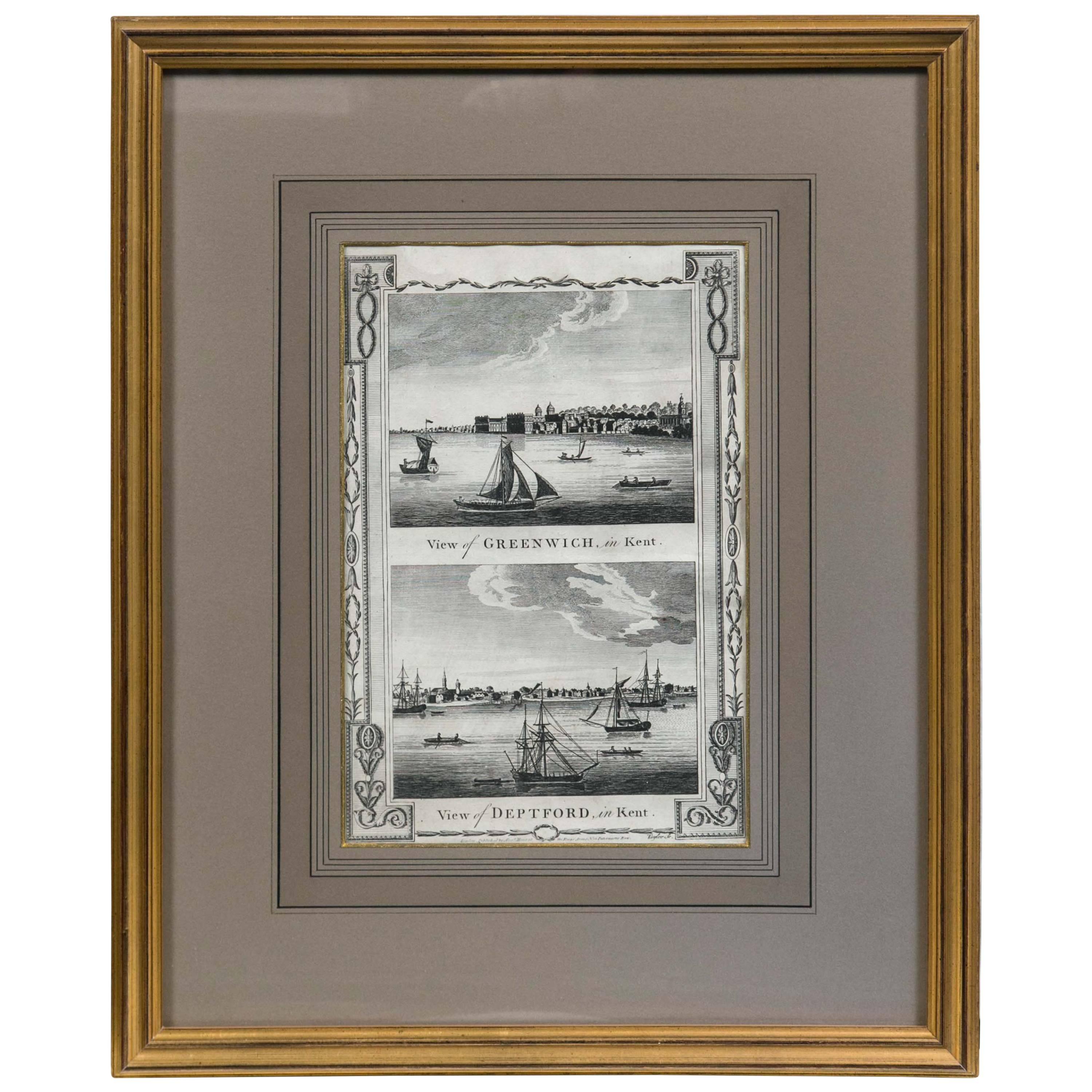Items Similar to 19th Century English Tinsel Print Portrait of Actor Retailed Saxon and Clemens
Want more images or videos?
Request additional images or videos from the seller
1 of 14
19th Century English Tinsel Print Portrait of Actor Retailed Saxon and Clemens
About the Item
A mid 19th century English full length portrait tinsel print hand colored and hand embellished, framed and retailed by Saxon and Clemens of New York City circa mid 20th century. This print depicts, "Mr. Freer as Marmion". This is one of three tinsel prints that I have available on my HKFA storefront here on 1stdibs. From the Robertson Davies Collection website, I would like to share with you this fascinating history of tinsel prints, "As the popularity of these prints became wide spread, bags of prepared tinsel decorations were sold along with the prints making them customizable by the purchaser. Thus after the tinseling process, no two prints would be identical. Tinsel prints emerged from the tradition of toy theatres. Once an appropriate model theatre was purchased, the public could buy prints depicting actors, actresses and scenery from plays that were being performed at the time and recreate those plays in their home. As the "juvenile drama" became popular, play books were published along side prints so the words of the plays could be recreated as well. While the genre flourished the desire to purchase a larger print of a specific actor or actress remained. Thus two types of theatrical prints became to be printed: those for juvenile dramas that were small and excluded specific actors names, and actors portraits that were larger and more individualized. In the larger theatrical portraits, characters were "always displayed full length" and "striking [a] habitual and dramatic pose". The 1830's marked the emergence of tinseling prints as a past time. Before this time, if an individual wished to embellish a portrait, individual sheets of metal foil would have to be purchased, measured and cut to fit an individual print. Once tinseling became common, different packages of precut tinsel (specific to the print)would be sold with each print as aforementioned. The term tinsel specifically refers to the metal sheets used to represent armor and weapons, but more broadly includes pieces of satin, silk, velvet, leather, and feathers among other embellishments. Although tinsel prints are now viewed as works of art, in the nineteenth century they were no more than a child's pastime. Most sources cite tinseling, as well as toy theatre, as being most popular among boys from the working class. Their popularity among boys could explain why male portraits were produced more frequently than female, however, it is more likely that male costumes, with their multiple pieces of armor and arms, offered more opportunities to use tinsel in comparison to the largely fabric costumes of women. Juvenile Dramas and accompanying prints as a whole experienced their heyday from the 1810's-1850's." And to further elucidate the tinsel print history, I offer this fascinating description from the Folger Shakespeare Library, "Tinsel prints are a unique English art form from the early and mid-19th century. They are typically composed of metal foils, fabric scraps, leather, feathers, and any other suitable material glued onto printed portraits of actors and actresses. Theatrical tinsel portraits have their roots in “patch portraits,” which were introduced to England by French prisoners of war in the late 18th century. This technique was embraced in England as a perfect home craft. Initially only the prints were acquired from the print dealer shop, and the metal sheets were cut out by the amateur tinseller to embellish his character. From the 1830s on this divertissement caught on so that you could acquire your embellishments in shops selling portraits and plays. The various metal tinsel shapes were produced by a gunsmith with an array of steel punches or dies that he would use for stamping out the different shapes and sizes, such as swords, helmets, spurs, or even minute dots to embellish the sword. These embellishments were varnished or glazed in a variety of colors, often red or green. Today this form of art has become quite rare, the remains in some forgotten attic." Overall height of the frame (not including the hanging hardware, is 10.75").
- Dimensions:Height: 12.75 in (32.39 cm)Width: 9.25 in (23.5 cm)Depth: 1.5 in (3.81 cm)
- Materials and Techniques:
- Place of Origin:
- Period:
- Date of Manufacture:1840's
- Condition:Wear consistent with age and use. In good antique / vintage condition with age appropriate wear. Some oxidation to the brass hanging hardware. Print has not been examined out of the frame.
- Seller Location:Atlanta, GA
- Reference Number:1stDibs: LU7240235755232
About the Seller
5.0
Vetted Seller
These experienced sellers undergo a comprehensive evaluation by our team of in-house experts.
Established in 2002
1stDibs seller since 2022
60 sales on 1stDibs
Typical response time: <1 hour
- ShippingRetrieving quote...Ships From: Atlanta, GA
- Return PolicyThis item cannot be returned.
More From This SellerView All
- 19th Century English Tinsel Print Portrait of Actor Retailed Saxon and ClemensLocated in Atlanta, GAA mid 19th century English full length portrait tinsel print hand colored and hand embellished, framed and retailed by Saxon and Clemens of New York City (original paper backing has been lost to time, however this print is similar to two others both from Saxon and Clemens) circa mid 20th century. This print depicts, "Mr. Collins as Sir Reginold the Bold in the Giant of Palestine". This is one of three tinsel prints that I have available on my HKFA storefront here on 1stdibs. From the Robertson Davies Collection website, I would like to share with you this fascinating history of tinsel prints, "As the popularity of these prints became wide spread, bags of prepared tinsel decorations were sold along with the prints making them customizable by the purchaser. Thus after the tinseling process, no two prints would be identical. Tinsel prints emerged from the tradition of toy theatres. Once an appropriate model theatre was purchased, the public could buy prints depicting actors, actresses and scenery from plays that were being performed at the time and recreate those plays in their home. As the "juvenile drama" became popular, play books were published along side prints so the words of the plays could be recreated as well. While the genre flourished the desire to purchase a larger print of a specific actor or actress remained. Thus two types of theatrical prints became to be printed: those for juvenile dramas that were small and excluded specific actors names, and actors portraits that were larger and more individualized. In the larger theatrical portraits, characters were "always displayed full length" and "striking [a] habitual and dramatic pose". The 1830's marked the emergence of tinseling prints as a past time. Before this time, if an individual wished to embellish a portrait, individual sheets of metal foil would have to be purchased, measured and cut to fit an individual print. Once tinseling became common, different packages of precut tinsel (specific to the print)would be sold with each print as aforementioned. The term tinsel specifically refers to the metal sheets used to represent armor and weapons, but more broadly includes pieces of satin, silk, velvet, leather, and feathers among other embellishments. Although tinsel prints are now viewed as works of art, in the nineteenth century they were no more than a child's pastime. Most sources cite tinseling, as well as toy theatre, as being most popular among boys from the working class. Their popularity among boys could explain why male portraits were produced more frequently than female, however, it is more likely that male costumes, with their multiple pieces of armor and arms...Category
Antique Mid-19th Century English Prints
MaterialsFoil, Brass, Metal
- 19th Century English Tinsel Print Portrait of Actor Retailed Saxon and ClemensLocated in Atlanta, GAA mid 19th century English full length portrait tinsel print hand colored and hand embellished, framed and retailed by Saxon and Clemens of New York City circa mid 20th century. This print depicts, "Mr. Freer as Alonzo the Patriot". This is one of three tinsel prints that I have available on my HKFA storefront here on 1stdibs. From the Robertson Davies Collection website, I would like to share with you this fascinating history of tinsel prints, "As the popularity of these prints became wide spread, bags of prepared tinsel decorations were sold along with the prints making them customizable by the purchaser. Thus after the tinseling process, no two prints would be identical. Tinsel prints emerged from the tradition of toy theatres. Once an appropriate model theatre was purchased, the public could buy prints depicting actors, actresses and scenery from plays that were being performed at the time and recreate those plays in their home. As the "juvenile drama" became popular, play books were published along side prints so the words of the plays could be recreated as well. While the genre flourished the desire to purchase a larger print of a specific actor or actress remained. Thus two types of theatrical prints became to be printed: those for juvenile dramas that were small and excluded specific actors names, and actors portraits that were larger and more individualized. In the larger theatrical portraits, characters were "always displayed full length" and "striking [a] habitual and dramatic pose". The 1830's marked the emergence of tinseling prints as a past time. Before this time, if an individual wished to embellish a portrait, individual sheets of metal foil would have to be purchased, measured and cut to fit an individual print. Once tinseling became common, different packages of precut tinsel (specific to the print)would be sold with each print as aforementioned. The term tinsel specifically refers to the metal sheets used to represent armor and weapons, but more broadly includes pieces of satin, silk, velvet, leather, and feathers among other embellishments. Although tinsel prints are now viewed as works of art, in the nineteenth century they were no more than a child's pastime. Most sources cite tinseling, as well as toy theatre, as being most popular among boys from the working class. Their popularity among boys could explain why male portraits were produced more frequently than female, however, it is more likely that male costumes, with their multiple pieces of armor and arms...Category
Antique Mid-19th Century English Prints
MaterialsBrass, Foil
- 19th C English Print by H. Strafford of Three South Down Wethers Kulicke FrameBy Robert KulickeLocated in Atlanta, GAThis is where the antique mixes with the modern. Where worlds collide and give rise to something fresh, new and unique. A mid 19th century British print by Henry Strafford presented ...Category
Antique Mid-19th Century English Prints
MaterialsMetal
- 19th Century British Print of Improved Lincolnshire Sheep in Kulicke FrameBy Robert KulickeLocated in Atlanta, GAThis is where the antique mixes with the modern. Where worlds collide and give rise to something fresh, new and unique. A mid 19th Century British print presented in a Kulicke frame which had it's origins in the mid 20th Century in America. This print of Improved Lincolnshire Sheep printed...Category
Antique Mid-19th Century English Prints
MaterialsMetal
- Monumental French Color Print by Henri Riviere Late 19th or Early 20th CenturyLocated in Atlanta, GAA late 19th or early 20th Century monumental color print by French artist Henri Riviere (1864 - 1951). The print shows a man and his horse in the French countryside, haystacks visibl...Category
Early 20th Century French Prints
MaterialsPlexiglass, Wood, Paper
- Monumental French Color Print by Henri Riviere Late 19th or Early 20th CenturyLocated in Atlanta, GAA late 19th or early 20th Century monumental color print by French artist Henri Riviere (1864 - 1951). The print shows a figure under an umbrella walking in a landscape with building...Category
Early 20th Century French Prints
MaterialsWood, Paper, Plexiglass
You May Also Like
- Framed Japanese 19th Century Woodblock Print of Kabuki Actors Toyokuni IIILocated in London, GBJapanese 19th Century Woodblock Print of Kabuki Actors Toyokuni III Original Woodcut by Toyokuni III (1786 - 1864) Of the Kabuki actors Bando Hikosab...Category
Antique 19th Century Japanese Prints
MaterialsPaper
- 19th Century Lithograph, a Portrait of a DancerLocated in Opole, PLWe present you this black and white lithograph depicting Caroline Vilhelmine Fjelsted (1821-1881), a Danish theatrical dancer. The author is Elias John Cardon. The graphic was ...Category
Antique 1840s Danish Prints
MaterialsPaper
- Framed Print, English Harbor Views, Early 19th CenturyLocated in Chappaqua, NYFramed print of English Harbor views, early 19th century, "View of Greenwich in Kent and View of Deptford in Kent." Custom frame and mat.Category
Antique Early 19th Century English Prints
MaterialsPaper
- Pair of 19th Century French PrintsLocated in Tarrytown, NYPair of 19th century prints.Category
Antique 1880s Prints
- Pair of 19th Century Neoclassic Framed PrintsLocated in Palm Springs, CAPair of 19th century neoclassic steel engraving prints. Professionally matted and framed.Category
Antique 19th Century Prints
MaterialsWood, Paper
- Pair of 19th Century Ornithological Color PrintsLocated in West Palm Beach, FLA lovely pair of 19th century ornithological color prints of European birds, within an elegant wood frame. The science of ornithology has a long history and studies on birds have hel...Category
Antique 19th Century Unknown Prints
MaterialsWood





